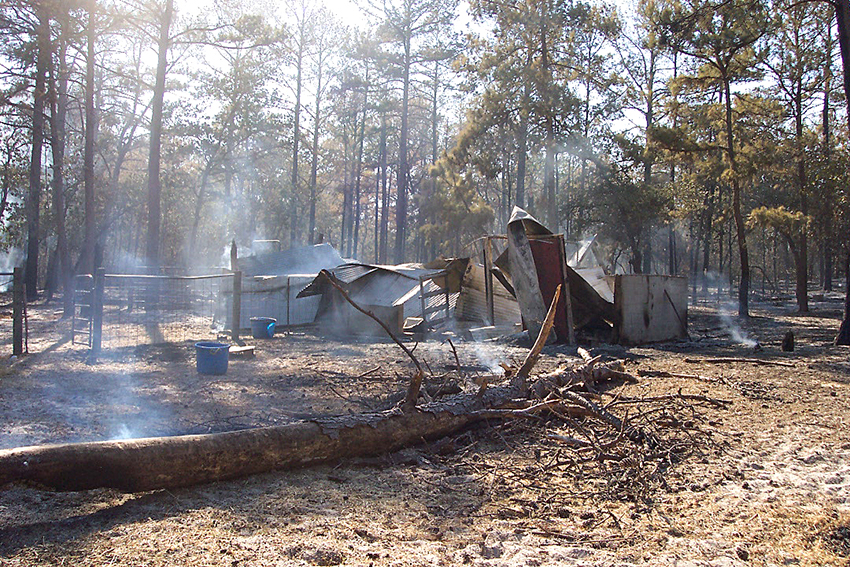“A lot depends on wind speed, how far the fire can jump, and where the nearest fuel source is, ” said environmental science lecturer Thoralf Meyer.
My aunt Dawn MacLean, like many Bastrop residents, has firsthand experience with this scientific principle. On Saturday, Sept. 10, 2011, MacLean and her family resided in a standard double-wide surrounded by pine trees. Over the dining table was a portrait MacLean drew of her daughter, Lindsay, when she was younger. Lindsay’s room was plastered in horse posters from her pony books collection.
Out back was a cement fire pit, and the cat had kittens under the porch. Through the trees, past the chicken coop and the old trampoline, a fence surrounded the barn. The goats’ blue plastic water buckets sat out front, and the horses grazed. By Saturday, Oct. 29, the buckets were the only things that remained.
“It was so funny, because the fire would jump so high, [and] there were plastic buckets still there — we’re talking feet from the barn — but the barn burned down.” MacLean said. The wind that day blew the sparks in unpredictable patterns, so while MacLean’s house, garage, and barn burned, her neighbor’s house and her goats’ water buckets were virtually untouched.
Five years ago, the Bastrop County Complex Fire burned for 35 days over 34,000 acres and destroyed an estimated 1,673 homes, including my aunt’s. The destructiveness of the wildfire was largely because of drought-stricken pine trees, which provided fuel, and strong winds blowing eastward from Tropical Storm Lee. However, Bastrop isn’t the only place facing wildfire risk.
Similar conditions are also present in Austin. Frequent drought, already common in central Texas, is being exacerbated by climate change, and central Texans need to re-examine our relationship with a wildfire-prone ecosystem.
“In the case of Austin, [we have] what Texans call cedar, which is actually a juniperus tree … which may take a while to ignite, [but] when it does, it’s going to blow up.” Meyer said.
Drought and heat cause evapotranspiration and the loss of soil moisture, leaving fuel for a wildfire and adding water vapor to the clouds. These clouds can blow eastward, and when combined with warm, evaporated sea water, can contribute to weather events such as Tropical Storm Lee in 2011.
As Austin grows, we build neighborhoods that add woody biomass to our traditional temperate grassland environment. When you factor this land change into the already existing topography and climate of the hill country, it results in a situation of simply waiting for the fuel to ignite. It’s scary to think history could repeat itself, but that is a real possibility.
“Environmental conditions have changed,” Meyer said. “Fire is an underestimated risk, and our exposure to it will change given Austin’s west and south expansion into the hill country.”
Today, the lives of those who were affected by the fire have been forever changed.
“After the fire, [my] husband, got a divorce and whatever. It’s just me out there now,” said MacLean, whose now grown daughter moved out on her own a few years ago. “But I love my property ‘cause when I go home, it’s why I moved out there — no pine trees anymore, but there’s still serenity,” MacLean said.
According to Meyer, the only way to continue preventing fire in Austin neighborhoods would be to remove excess fuel, and the only way to do that is mechanical removal, or cutting trees down. If we were able to do this, it would hopefully help to restore a more natural savanna ecosystem. But even natural savanna ecosystems are characterized by periodic burns, so it may not be a question of “if” but a question of “when” and “where” and “how can we be better prepared?”
MacLean is an advertising sophomore from Austin. Follow her on twitter @maclean_josie





















